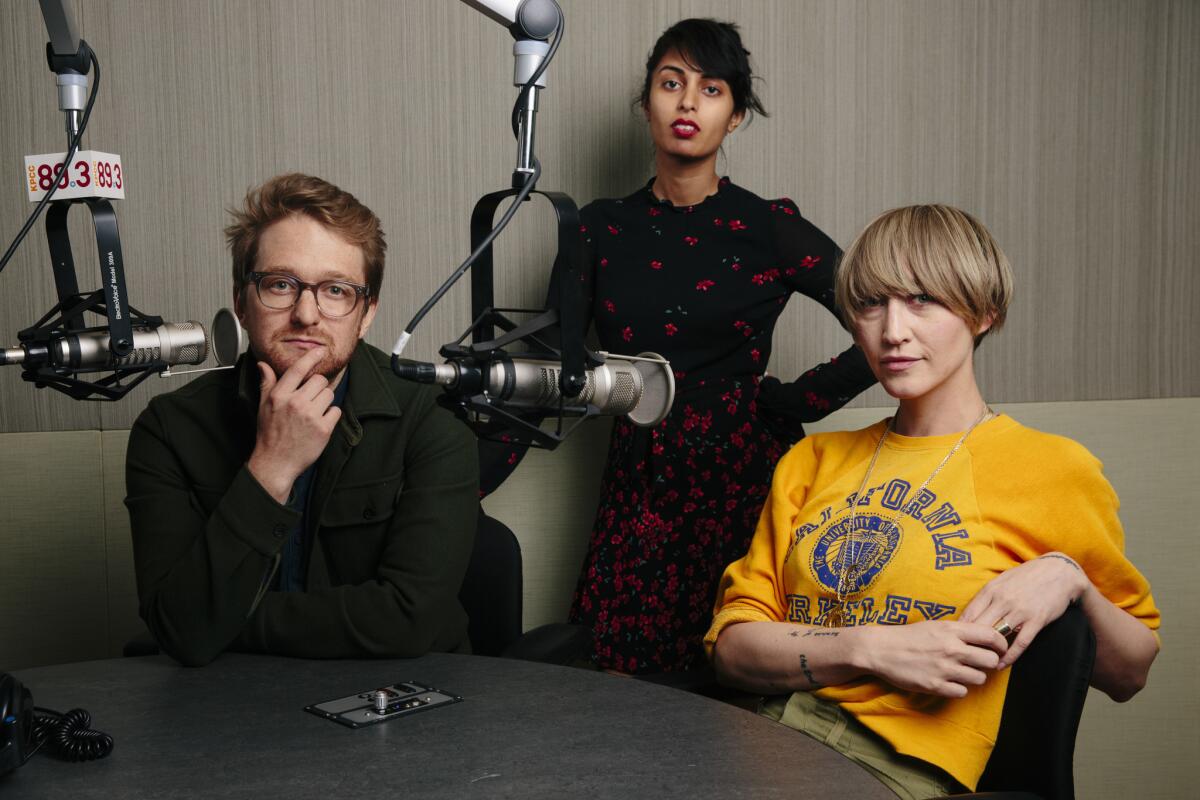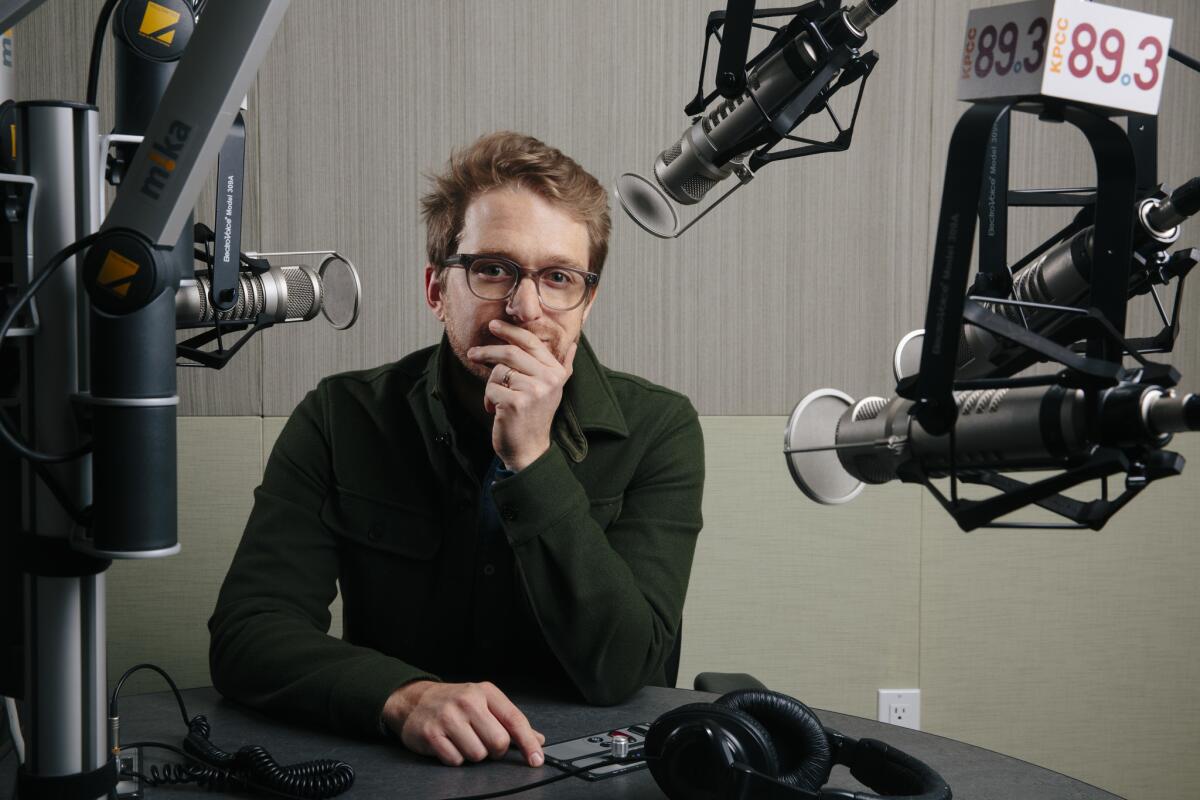Audiosphere: Don’t panic, but ‘The Big One’ podcast helps us face the crazy quake that’s on the way

- Share via
For those who went through it, the 1994 Northridge earthquake was plenty big enough. Fifty-seven were killed, 8,700 were injured, and the damage was in the tens of billions. Freeways collapsed. The scoreboard of Angel Stadium fell onto (unoccupied) seats. The shaking reverberated throughout the Greater L.A. area in the middle of the night, and it was terrifying. But it wasn’t a Big One.
That designation refers to a quake measuring 7.8 or larger in magnitude (Northridge was a 6.7), which tends to happen — or come close to happening — in the southern section of the San Andreas fault approximately every 100 years. There hasn’t been one there since 1857.
“The last time one struck, there was no Union Station, no Hollywood, no freeways to destroy or skyscrapers to crumble, no fifth-largest economy in the world to cripple,” Jacob Margolis warns gently in the KPCC podcast “The Big One: Your Survival Guide.”
“We don’t know when the Big One’s gonna hit,” Margolis says. “It could be in a year, it could be a week, or literally any minute now. But we do know that when it does, you’ll have an overwhelming feeling that Mother Nature doesn’t care. That you’re small.”
ALSO: The ‘Wild Thing’ podcast is like ‘Serial’ for Sasquatches »
Margolis is a first-time podcast host and also a first-time father. He and his wife, Rachel, feature as characters in “The Big One,” with their household conversations being played back as they prepare themselves, physically and mentally, for a massive earthquake that almost certainly is going to hit within their young child’s lifetime.
You’re featured in the podcast as well: The central structure of the recently concluded nine-part series is a second-person “hero” narrative detailing what it would be like to go through a Big One, from initial impact to societal rebuild. It’s supposed to rattle you and to wake you into action (no matter how much water you have stored, get more), but it’s not supposed to scare you. At least not too much.

“Fear is incredibly fatiguing, and we also know from the research we did that it’s not effective,” says KPCC head of podcasting Arwen Nicks, sitting in a radio studio, flanked by Margolis on one side and “Big One” lead producer Misha Euceph on the other.
“To fearmonger and be like, ‘1,800 people could die and the city will be on fire’ — two things that are also very likely — is not going to motivate you.”
The three speak soothingly, in dulcet public-radio tones, about the inevitable destruction of the city. They cite offhand the U.S. Geological Survey’s ShakeOut report, from 2008, which predicts that a Big One’s impact on Los Angeles would be, generously, an estimated 1,800 dead, 50,000 injured, and $200 billion in damage.
We don’t know when the Big One’s gonna hit...But we do know that when it does, you’ll have an overwhelming feeling that Mother Nature doesn’t care.
— Jacob Margolis, “The Big One” podcast host
“You’ll burn out on that really quickly,” Margolis says. “And that’s kind of what I found reading this stuff. You could do a three- or four-minute radio piece on just the disaster, and that would be enough for most people. But I think that drove us toward finding that [second-person] narrative so that we could tell it in a way that wasn’t just like, ‘Blegh, here’s all this terrible stuff.’ ”
The resulting podcast is one with a scientific core, covered in a sugary, disaster-movie outer shell.
To give an idea of how that fits together, the “Big One” crew is just as keen to discuss the career of Lucy Jones, a real-life superhero in the earthquake community who served as a consultant on the show, as they are to discuss the merits of various earthquake-movie protagonists (Tommy Lee Jones in “Volcano” as a dedicated public servant; Dwayne Johnson in “San Andreas” as a questionably AWOL search-and-rescue commando). “I mean, I’ve got an oil painting of Bruce Willis as John McClane on my desk,” Nicks says with a laugh.
ALSO: Looking for a comedy podcast? Earwolf has dozens to make you laugh »
It was Euceph, Nicks says, who predominantly sculpted the sound of the show, who found the best way to merge those worlds.
“I asked Lucy Jones, ‘Can you make a noise to explain the difference in magnitudes?’ ” Euceph remembers. (A 7.8-magnitude earthquake would be 44 times stronger, and last more than a minute and a half longer, than Northridge.) “Like, ‘Can you just drum on the table or rip up some paper or whatever?’ And she was like, ‘Actually, the perfect way to do this is by playing the viola da gamba, which I play.’ ”
“Not the viola,” notes Margolis. “The viola da gamba.”
Jones’ stringed demonstration of just how comically large a Big One will be is one of the show’s most compelling — and unsettling — moments. It also creates an eerily fitting context for the show’s cinematic score, composed by Andy Clausen.
“We wanted to make sure people were entertained, but we also wanted to make sure the journalism was unimpeachable,” Margolis says.
Fear is incredibly fatiguing, and we also know from the research we did that it’s not effective.
— Arwen Nicks, KPCC head of podcasting
Disaster-movie narrative notwithstanding, there’s no dramatic blockbuster finale by series’ end, no culminating scene in which our hero miraculously emerges from the rubble. Instead, the producers chose to impart practical lessons of preparedness (store water in every room, and have earthquake kits in your home and car), as well as emphasize a few hard-earned lessons of human nature in the event of a disaster.
“Even if we don’t have the infrastructure,” Euceph says, “and the emergency responders, and the resources to perfectly meet this disaster, we do have people helping each other, and we’ve seen that time and time again. I bet you anything we will see it when this earthquake does strike.”
Margolis also recommends reading Jones’ recent book, “The Big Ones,” for further information on natural disasters and how to prepare for them.
“Maybe take a break,” Nicks says, “and watch, like, ‘The Good Place’ before reading that.”
More to Read
The biggest entertainment stories
Get our big stories about Hollywood, film, television, music, arts, culture and more right in your inbox as soon as they publish.
You may occasionally receive promotional content from the Los Angeles Times.










